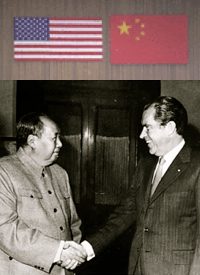
Today marks the 40th anniversary of the infamous Shanghai Communiqué, the joint diplomatic agreement between the United States and the People’s Republic of China issued during President Richard Nixon’s visit to Communist China in 1972. In the document, the two nations pledged to work toward "normalization" of their economic and cultural relations. They further agreed that neither country would "seek hegemony in the Asian-Pacific region." On February 28, 1972, the United States also acknowledged the "One China Policy," and agreed to cut back on its military bases on Taiwan (the Republic of China or "Free China").
“Only Nixon can go to China” was a famous line in 1972. And so Nixon used his notional “anti-communism” to trek to Beijing, following National Security Advisor Henry Kissinger’s "realpolitik" (a system of politics based on practical rather than moral or idealogical considerations). But there was just as much domestic politics at stake. The economy was moving along well, and if Nixon could appear to be a brilliant master of foreign affairs, then his chances of winning the presidential election in November would be much greater.
President Nixon signed the Shanghai Communiqué, a document which Kissinger boasted had “constructive ambiguity.” When the United States acknowledged that there was just one government of China, Nixon did not then say in so many words that the totalitarian communist regime in Beijing was that government.
America’s Secretary of State at the time, William Rogers — the principal official in charge of foreign affairs — was kept out of the loop by the President and others. Nixon’s preventing the Secretary of State from participating in these crucial negotiations led directly to Taiwan losing diplomatic recognition throughout much of the world, while it also accomplished nothing to promote freedom and peace around the globe.
At the time of the Shanghai Communiqué, China was ruled by one of the most brutal totalitarian despots in modern history, Mao Tse-tung. Although no one in the West knew exactly how many people he had murdered, tortured, starved, or “re-educated,” the desperate refugees steadily flowing into Hong Kong and Macao brought with them tales of brutality that equaled anything that Hitler or Stalin had ever done. Diplomats who endured the “Great Cultural Revolution” came back with stories which demonstrated that Maoists had no respect for diplomatic immunity or the sovereignty of embassies.
Anti-communists in America were warning anyone who would listen that Mao was engaging in virtual genocide in Tibet. Long before it became chic to champion Tibet, anti-communists were enduring scorn for "besmirching" the People’s Republic, which Americans had been told was an improvement over Chiang Kai-shek’s Party of the People (Kuomintang), which escaped to Taiwan in 1949.
After Mao died, the dimensions of his crimes became clearer. Judith Banister, in her 1984 study China’s Changing Population, put the deaths caused by Mao at over 30 million. R.J Rummel, a professor who has specialized in this grisly work, estimated that 34 million Chinese died under his rule. Jung Chang — whose recent book, Mao: The Unknown Story, provides more details than that of any other analyst — sets the deaths caused by Mao at more than 70 million souls. The book is based on a decade of research and interviews with many of Mao’s closest associates, who told their stories for the first time to Chang.
A thorough exposition on the utter devastation that communism has caused in China may be found in the 2012 book, Why China Will Never Rule the World, by Troy Parfitt, an iconoclastic Canadian who finds mainland China today almost sociopathic in how its people and government behave. Having taught English in Taiwan for 10 years, Parfitt leaves no doubt that life in Taiwan is incomparably better — far more decent and humane — than in Communist China.
Three years after the Shanghai Communiqué was signed, North Vietnamese tank divisions would roll into Saigon. At the same time, the Khmer Rogue would take over Cambodia and begin the "Killing fields." Communist China helped both regimes.
The stories of sadism and torture in Chinese jails and prisons are beginning to percolate out now. Tang Baiqiao, a student leader at Tiananmen Square, has penned a chilling description of what he experienced firsthand in his 2011 book, My Two Chinas: the Memoir of a Chinese Counterrevolutionary. It is as grim as anything in Aleksandr Solzhenitsyn’s Gulag Archipelago. Baiqiao was tracked down by Chinese officials after the Tiananmen Square protests, jailed, and tortured. After finally being released, he made his way to America, where he has been living in exile ever since — still campaigning for human rights and freedom in mainland China and around the world.
Where do most refugees from Red China go? They often wind up in Taiwan, the relatively free and amazingly prosperous island nation which Nixon had dismissed as the model to carry on the traditions of (once-free mainland) China.
Nixon’s ugly legacy — including the creation of the Environmental Protection Agency, Affirmative Action, OSHA, and other unconstitutional acts — weighs heavily on Americans today. But few proclaimed victories of Nixon’s presidency were more loudly cheered at the time or seen as disastrous in hindsight as the Shanghai Communiqué.
Photo: Richard Nixon meets with Mao Tse-tung in Beijing, February 21, 1972.



